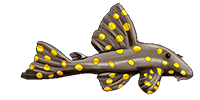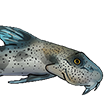Quo wrote:another stores was selling these guys as A. dolichopterus and another as A. temminckii . So are these stores cheating?
Possibly, but there are certainly several books, web-sites and wholesalers that label the common bristlenose as either
A. dolichopterus or A. temminckii.
A. dolichopterus is relatively easy to tell apart, as it's a black fish with really bright white spots, and more distinctive, it has at least 9 rays in the dorsal fin, which is very unusual in
Ancistrus.
A. temminickii, we can't say quite so surely that it's NOT, except for the fact that there is no export from Suriname, and there hasn't been any for many, many years (if ever, really). It just happens to be a fish that looks roughly the same - as does MANY others.
As Gary (2wheelsx2) says, the shop will sell fish "as sold to them", and most wholesalers and importers won't really care much about what the species is UNLESS it will give them more money.
Typically, here in England, youngsters sell in shops for about £3-5 (US$5-8) each (2.5cm/1" size), and adults anywhere from £8-20 (US$12-30) depending on shop. The adults upper end is similar prices to wild-caught "not too unusual looking" medium sized fish. But an adult
A. dolichopterus will almost certainly cost in the range of £20-40 ($30-60), depending on shop. So about twice the price of a "common" fish.
Please be aware that prices vary from region to region, shop to shop, supply & demand, local competition, transport costs and many other things. So whilst those prices may be what I pay, someone living in Australia may be happy if they can get baby bristlenoses for less than US$30 [I don't actually know the prices in Australia, but I know they are much higher than here!]
In fact, the male and the female despite looking different already bred twice.
Another reason to believe they are actually the common species - they breed as long as there is water and food in the tank (Ok, you may need to make a little more of an effort than that, but they are really quite easy to breed).
Your female looks fairly similar to what my female looks like these days, quite dark with no noticable spots, and that's the same fish as in this picture:

(In this picture, the fish is about 1 year old, and I've had the fish for almost 7 years now)
--
Mats















